



Chem 212 Unit 2 Jeopardy
Activity • 200 • 400 • 600 • 800 • 1000
Activity - 200 Write the solubility product for La(IO 3 ) 3 activity coefficients. K=[La3+] γ La+ [IO 3 -]^3 γ IO 3 -
Activity - 400 What is the equation to solve for Ionic Strength? µ= ½Σ cz^2
Activity - 600 A solution contains H+, CN-, Mg2+, ClO 4 -, and H 2 O. What is the Charge Balance equation for this solution? [H+]+2[Mg2+]=[CN]+[ClO 4 -]
Activity- 800 What is the initial Mass Balance equation for an equilibrium of CaCl 2 , Ca2+, Cl-, CaCl+, and CaOH+? 2([CaCl 2 ]+[CaCl+]+[CaOH+]+[Ca2+])=2[CaCl 2 ]+[Cl-]
Activity - 1000 What are the six steps of the Systematic Treatment of Equilibrium? 1. Write the chemical reactions 2. Write charge balance 3. Write Mass Balance, possibly more than one 4. Write equilibrium expression for each chemical reaction 5. Count equations and unknowns 6. Solve for all unknowns
Acid-Base Equilibrium • 200 • 400 • 600 • 800 • 1000
Acid-Base Equilibrium 200 Match [BH+][OH-] Acid dissociation [B] constant [H+][A-] [HA] Base hydrolysis constant
Acid-Base Equilibrium 400 How do they work? • Buffers work by having both the acid/base and its conjugate base/acid respectively. They resist change because when a different acid or base is added, the acid/base and its conjugate react with the added acid/ base and neutralize it, making the overall change in [H +] near zero.
Acid-Base Equilibrium 600 When is it appropriate to use the Handerson- Hasselbalch Equation? Write the Handerson Hasselbalch Equation • Handerson-Hasselbalch equation can be used when [A-]=[HA], and therefore pH=pKa • pH=pKa + log ([A-]/[HA])
Acid-Base Equilibrium 800 Find the Ka of a weak acid, which has pH=5.31 in a 0.1M solution 10^(-5.31)=[H+]=4.90e-6 Ka=(4.90e-6)^2= 2.40e-10 0.1-4.90e-6
Acid-Base Equilibrium 1000 To produce a buffer with pH of 5.27, starting from a solution of 0.1M acetic acid, what concentration of sodium acetate is needed? (pKa=4.76) pH=pKa + log ([A-]/[HA]) 5.27=4.76+log(x/0.1) log(x/.1)=.51 x=.1(10^.51)=.32M
Thermodynamics • 200 • 400 • 600 • 800 • 1000
Thermodynamics 200 For a reaction to be spontaneously favored, ∆ H should be? ∆ S? ∆ G? And what do ∆ H, ∆ S, and ∆ G stand for? ∆ H (Enthalpy) = -, ∆ S (Entropy) = +, ∆ G (Gibbs Free Energy) = -
Thermodynamics 400 What is the difference between K and Q? What happens when K=Q? K is the equilibrium constant, whereas Q is the reaction quotient, and it is evaluated at whatever the concentrations happen to be. When K=Q, the system is at equilibrium
Thermodynamics 600 What is the equation for determining Gibbs free energy? ∆ G = ∆ H - T ∆ S
Thermodynamics 800 Le Chatelier’s Principle states that if heat were added to an endothermic reaction, which way would the reaction proceed? To the right. Endothermic: Heat + reactants = products
Thermodynamics 1000 What is K for a reaction if ∆ G = -50kJ/mol and the reaction occurs at 25ºC K= e^-(-50x10^3 J/mol)/ [8.314472J/(K*mol)](298.15K) = 5.75 x 10^8
EDTA 200 400 600 800 1000
EDTA 200 What does EDTA stand for, what is it’s structure and why is it important? EDTA stands for EthyleneDiamineTetraacetic Acid Neutral H 4 Y form It is important because it has up to 6 available electron pairs which it can use to form unusually stable complexes with metal cations. Virtually all elements on the periodic table can be measured directly or indirectly with EDTA.
EDTA 400 How Does EDTA react with cations? n-4 + M n+ The EDTA molecule in it’s most deprotonated form acts as a lewis base donating electron pairs from it’s carboxylate and ammonia groups. The metal center acts as a Lewis Acid electron pair acceptor forming a metal complex. Many geometries are possible in the product but most metals will form an octahedral complex with their d orbitals.
EDTA 600 M n+ + Y 4- → MY n-4 K f = [MY n-4 ]/([M n+ ] [Y 4- ]) This is the expression for complex formation however the concentration of Y 4- varies with acidity. α Y-4 Was empirically determined at various pH values as the proportion of EDTA molecules found in the active form Y 4- If α Y-4 = 0.041 at pH 9, what will the conditional Formation constant be for the following reaction? Ca 2+ + Y 4- → CaY 2- K f = 4.467x10 10 [EDTA]* α Y-4 = Y 4- so: K f = [MY n-4 ]/([M n+ ][EDTA]* α Y-4 ) = K f * α Y-4 =K’ f K’ f =(0.041)4.467x10 10 = 1.83x10 9
EDTA 800 In titration the equivalence point is the point where the concentration of the analyte is the same as that of the titrant. if 1.5L of 0.079M Cu 2+ is titrated with 0.2M EDTA what will the equivalence point of the reaction be? What will the Concentration of CuY 2- be at the equivalence point? 1.5L(0.079M) =V eq (0.2M) V eq = 0.5952L When the titration reaches V eq Virtually all the Cu is in the form CuY 2- so: [CuY 2- ] = (original concentration Cu 2+ )(dilution factor) =0.079M(1.5/(1.5+0.595)) =0.0567M
EDTA 1000 100ml of 0.05M AgCl is titrated with 0.05M EDTA at pH 10 what is the concentration of Ag + at V= 50? (V eq = 100ml) What is the concentration of Ag + at V=100ml Ag + +Y 4- → AgY 3- K f = 1.58x10 7 α Y-4 = 0.30 at pH 10 K f * α Y-4 =K’ f =1.58x10 7 (0.3)=4.75x10 6 at V=50ml: [Ag + ]= ((proportion of Equivalence point)(Original Concentration Ag + )(dilution factor) =(100-50)/100)(0.05)((100/(100+50))=0.0167M at V=100ml [Ag + ] is very small and unknown 4.75x10 6 = [AgY 3- ]/([Ag + ][Edta]), [AgY 3- ]=(Original Concentration Ag + )(dilution factor)=0.05M(100/200)=0.025M 4.75x10 6 =(0.025M-x)/x 2 , Solving with quadratic formula yields x=[Ag + ]=7.24x10 -5
Recommend
More recommend